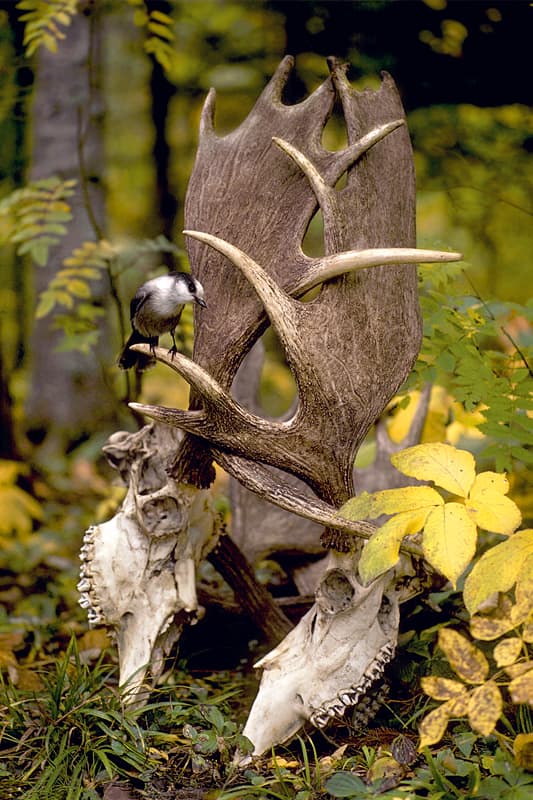 Jim Brandenburg travelled the world as a photographer with National Geographic magazine for more than 30 years. His work has been published in The New York Times, Life and Time, among others, and he has won numerous awards, including Kodak Wildlife Photographer of the Year by the Natural History Museum and BBC Wildlife Magazine. He is the chair of this year’s competition. Every month Jim will share the story behind one of his nature images
Jim Brandenburg travelled the world as a photographer with National Geographic magazine for more than 30 years. His work has been published in The New York Times, Life and Time, among others, and he has won numerous awards, including Kodak Wildlife Photographer of the Year by the Natural History Museum and BBC Wildlife Magazine. He is the chair of this year’s competition. Every month Jim will share the story behind one of his nature images
I stumbled upon this scene while out walking in the Isle Royale National Park in Lake Superior in the Great Lakes region of North America. The island, surrounded by almost 600 miles of water, is a closed ecosystem, and home to wolves that prey upon moose. It’s one of the oldest study sites in the world of predator/prey relationships and that intrigues me as a behaviourist and naturalist, so this picture helps to tell a bit of a story about the island.
This image was taken in the late 1970s and it’s one of my oldest pictures, but I’d be happy if I shot it today. What this scene shows are the remnants of two moose that were fighting during a rut. Occasionally, their antlers get locked and they cannot pull themselves apart so they die like that. I know the wolves were fairly numerous on the island back then, so I fully expect they would have soon killed the moose and started eating them.
The scene is as I found it – I didn’t set it up or try to pull the skulls apart or change the layout in any way. What you see in this photograph is a natural occurrence and quite a common one. Every year I hear of someone seeing something like this. Unfortunately, the moose antlers grow with a number of ‘hooks’ that can become entangled when two sets of antlers are slammed together.
What makes this picture special for me, and what I think makes it unique, is the presence of the grey jay perching on one of the antlers. Without that bird, this picture would be nothing.
The grey jay is a very special bird to me, as I see them all the time where I live. This particular species is known as a scavenger. The birds will follow the wolves, and when the wolves make a kill they will scavenge off the carcass. They’re very curious and very intelligent birds that have very little fear. They also follow people around, stealing food and eating straight out of your hand, and for this reason they are known locally as ‘camp robbers’. I don’t know of any other bird in the world that does this.
On this particular day, the grey jay was probably following me around looking for food. I don’t have any memory of having to wait around for it to land – it just popped down there, probably snooping around for a little morsel of food from me or from the skulls. I often talk about serendipity and luck within the images I shoot, but I wouldn’t call this a particularly lucky moment. I was lucky to see the skulls, but the birds are quite common and they had followed me through the woods before on numerous occasions.

When the bird landed, I was already at the skulls, trying to work out a way to shoot and frame them. I knew the bird would soon become bored and move off, so I had to shoot fairly fast. As a result, I didn’t spend long thinking about the composition because I didn’t have much time to think about it.
Back then, there were no automated cameras: my Nikon had no autofocus and everything was shot manually with a handheld light meter. I think I was using a medium telephoto or possibly a fixed lens, most likely a 200mm, so I was shooting from a distance in order not to disturb the scene. I had to know my camera and settings inside out to be quick enough to get a shot like this.
Had I missed capturing the grey jay in the frame, the image would be fairly average. The bird adds some spontaneity to the photograph and speaks volumes about the behaviour of these birds – you learn as much about the grey jay as you do about the moose. For example, the grey jay’s presence tells you that it is on the lookout for free food, and that it will feed on the carcasses of animals. From this picture, you can also begin to understand the relationship between the birds and the carcasses: it shows that the birds visit the carcasses not just to eat, but also to collect the fur of dead animals that they then use to line their nests.
As well as this, the image also provides an insight into the harsher side of the natural world. People who aren’t surrounded by nature can sometimes misinterpret the natural world as being serene and full of happiness. But nature can be very cruel: life comes and goes with the wind, wolves kill animals and eat them when they’re still alive, and occasionally something like this happens when two moose in their prime die together. In war and combat there are downsides, and this not only tells the story of a grey jay scavenging, but it also speaks of a tragic death of two regal animals at the peak of their lives.
Jim Brandenburg was talking to Jade Lord
To see more of Jim’s images visit www.jimbrandenburg.com







